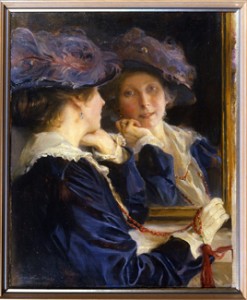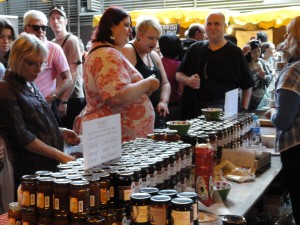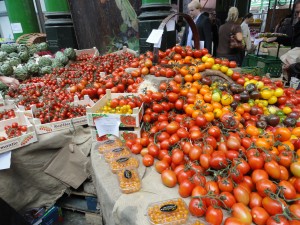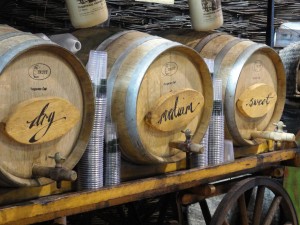I think we can all agree that the National Portrait Gallery is filled with the white and wealthy. There were very few portraits of people of color, and even then they could only be found in the modern section. I found this was also true with portraits of women. Most of the the paintings seemed to feature men. As a woman, I found this both sad and frustrating. I was also disappointed by the fact that in the earliest collections of portraits almost every face looked the same. When I commented on this to Amy, she told me that at this time sitters would pose in order to look dignified, influential, and noble. This answers some of my question, but looking beyond the posing to the actual faces, I was still struck by the replication of features. It made me seriously question the legitimacy of each likeness. I wonder to what degree the artist might have altered the sitters actual appearance and if so, was it done for a reason?
The portrait I chose, Mrs Philip de László has a bit more personality.  (Photo taken from the National Portrait Gallery, http://www.npg.org.uk/whatson/display/philip-de-laszlo.php)
(Photo taken from the National Portrait Gallery, http://www.npg.org.uk/whatson/display/philip-de-laszlo.php)
I picked this portrait because I simply just fell in love with it. I hadn’t ever heard of Philip de Laszlo before today, but my eye was immediately drawn to his collection which featured more women than some of the other artists. This portrait is of Lucy, his wife. I think the idea of painting both her actual body and her reflection adds some originality. It is certainly mush different than the stiff dignified portraits of the Tudors and Elizabethans. The portrait reminds me more of a candid photo. Her chin rests on the palm of her hand in a very relaxed but graceful manner. But I think it is her eyes that really make the painting. Instead of looking upon her own reflection in the mirror, her gaze is focused on her husband. This changes the tone of the painting into something much more intimate and warm. It brings much more life to the sitter than the repetitive blank faces of the first portraits we saw.
Entries Tagged as '2010 Sarah'
National Portrait Gallery
September 3rd, 2010 · 2 Comments
Tags: 2010 Sarah
Borough Market
August 28th, 2010 · 12 Comments
Leaving the Arran House, we decided to travel the Northern Line from Goodge Street to London Bridge. From there it was a quick walk across the street to Borough Market, which includes Jubilee, Green, and Middle Market. Borough Market can be found tucked behind the Southwark Cathedral.
Before we even fully entered the market, we were hit by a blast of smells. Borough Market is an upscale, artisanal food and foodstuffs market, featuring booths selling everything from specialty fromage, to fresh produce, seafood, wine and beer, and traditional and exotic meats– ostrich! The market was extremely crowded, with people walking through shoulder to shoulder. We were separated from each other at several points due to the shuffling throngs of people.
Due to the high-priced nature of the vendors, the patrons (minus tourists like us) visiting the market appeared to us to be of a higher socioeconomic class. Racially, they were fairly homogenous. Slight variations could be seen from booth to booth, depending on what was being sold. For example, Mikey was passive-aggressively asked to leave a wine booth as he was writing in his notebook, while the booths selling cider tended to cater to the less affluent.
There was almost every sort of food one could hope to find at a market, so in the blog we will just document some of the more surprising or delicious options.
The market as a whole was eco-conscious. Most meats and produce were organic/free-range, and packaging for products was often biodegradable. There were also many interesting and noteworthy foods that were available and that make Borough market worth the trip. At a sausage stand beef, wild boar, venison and ostrich were available (The ostrich, by the way, was delicious.)
At another stand a giant, sliced, puffball mushroom was available. Exotic and expensive fruits such as whole figs and pomegranates were available, and we passed a crepe stand offering fillings of the savory, spicy and sweet variety. Whole fish were for sale, along with squid, scallops and halibut. We were intrigued by a stand vending elderflower cordial, though, as with most of the items of intrigue, it was pushing five quid for even a small drink. At a fine meat stand, there was a sign touting the benefits of the ostrich eggs they were selling- including the rather astounding fact that one ostrich egg is equivalent to twenty chicken eggs- as well as offering a kangaroo burger. We saw duck eggs and whole game mallards, whole hams and various wild boar meats. The upscale beer store was rather astounding as well.
[kml_flashembed movie="http://www.youtube.com/v/BsKDppaXydY" width="425" height="350" wmode="transparent" /]
http://www.youtube.com/watch?v=BsKDppaXydY
If anyone is looking for high-quality specialty foods, the Borough Market is the place. It is lively, expansive, and an a fun experience.
Tags: 2010 Michael · 2010 Rachel · 2010 Sarah
Elephant and Castle
August 28th, 2010 · No Comments
Our trip to Elephant and Castle took no more than fifteen minutes. We entered the Tube at Goodge Street, transferred at Charing Cross, and took the Bakerloo Line a few stops to Elephant and Castle. The route was fairly simple and easy to follow. We decided however, that the connecting tunnels are in dire need of shortening, and that there are a few misplaced “Way Out” signs. To return to the hotel, we transferred at Kennington and took the Northern Line straight home to Goodge Street. The ride back was almost identical to the trip getting there.
There were no obvious clues as to why the station was named as it was, so we decided to do a little further investigating. This lead to a rather awkward interview with an Underground employee. When we asked him if he knew why it was named Elephant and Castle, all he did was stare at us with the much dreaded “Stupid Americans” look. The internet proved to be a more helpful and much less embarrassing source. We started out by looking at Wikipedia and discovered that the area was named after a coaching inn. Another site explained that “The Elephant & Castle was once considered the ‘Piccadilly Circus of South London’, but these days it is a centre of student life”. The station’s presence is important because it is a center for South London transport. It seems that mostly local residents make use of the station.
As soon as you exit the Tube, you can see the statue of a red elephant with a castle on its back. It seemed, like many of its surroundings to be worn and run down. Its main purpose seems to be to draw attention to the fact that the area is a historical site. Sadly, we were the only people who seemed to take note of it. Everyone else was too busy or hurried to care.
The people in the area seemed to be of lower socioeconomic class. The street was lively, filled with conversation, and had an odd mixture of run down construction sites and classic architecture. In the far background a shiny, modern skyscraper is visible.
Tags: 2010 Luke · 2010 Sarah







